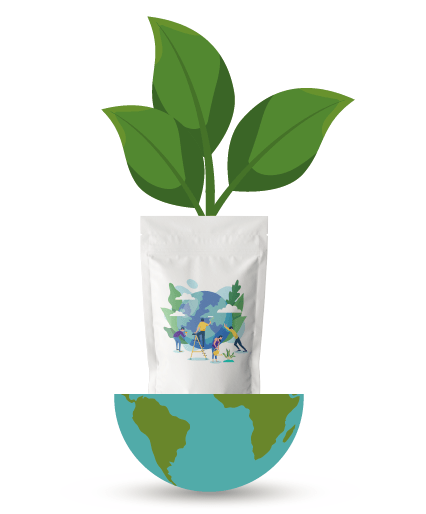No products in the cart.
Why Sustainability Branding &
Sustainable Brands are
So Important Right Now


Sustainability is a concept that has been tossed around for decades, but recently there has been reinvigorated energy behind sustainable brands that is here to stay. More people now understand the implications that harmful emissions have on the future of life on our planet, and the numbers will only continue to rise. But is the concept of sustainable branding and business practices easier said than done? Thankfully, not anymore. It’s easier than ever to bring sustainable branding to the forefront of your business, and take a plethora of benefits along with it. So what does it take to be branded as a sustainable brand? Learn more.


Sustainability branding is so important right now because the environment and future generations depend on us to act now, consumers expect environmentally friendly practices from a sustainable brand today, the process and implementation are accessible, and the benefits are astronomical. The solutions for all brands, but especially packaged goods (CPG) brands, to move towards more sustainable options are here to stay. It’s essential to take advantage of this right now during this pivotal moment in history before it’s too late.
The Earth Needs Sustainability


Everything you do, make, and consume has a so-called “carbon footprint," or an impact on the environment. From the foods you eat to the energy you use, all of the systems we’ve had in place for generations have not been set up with the Earth’s wellbeing in mind. Yet when something is sustainable, it minimizes this impact through something that can be done again and again without depleting resources or compromising the future.


Everyone plays a part in emissions that are harmful to the planet, from the individual level up to corporations and governments. But a sustainable brand has an especially powerful responsibility to protect the Earth. Consumers look to brands to get a sense of identity, understand how their founders and employees think and feel, and shape their opinion of the world around them. When brands are pushing the morally right choice of living sustainably, the impact will trickle down and do more good than you may initially realize. This is why sustainable branding is so important.


In addition to the far-reaching impact that sustainable branding has, the Earth needs us to act now to prevent natural disasters. As global temperatures continue to rise, the disaster and destruction that will come with rising sea levels and heat waves will be horrible. If you care about the environment you must know that every little bit counts. That’s why your brand should be prepared to make a switch today.
Sustainable Branding Infographic


How Businesses Can Adapt to Sustainability
But isn’t switching entire brand operations to implement more sustainable practices incredibly difficult? Perhaps a few decades ago, but today, shifting to sustainable brands is easier than ever.
Sustainability is a full-circle concept, meaning all of your actions, practices, materials, and habits come into play. In a high-level way, all sustainable clothing brands do differently is reduce or eliminate their harmful emissions and waste, use better materials, and operate in a more efficient and Earth-friendly way. But what does that actually mean?


To think about how brands can become sustainable, we have to take a look at their consumption and the way you operate. Do you make deliveries in gas-powered vehicles? Perhaps switching to an electric fleet can reduce your greenhouse gas emissions. Do you have excess product that you’ve historically thrown out? Try donating or repurposing this “waste” into a new creation that benefits your brand and those around you. Are your materials full of plastics that will end up in a landfill? Try switching to recyclable, biodegradable, or compostable alternatives. Other options to look into include switching to a remote or hybrid workplace to reduce building and commute emissions, getting electricity from renewable sources such as wind and solar, and offsetting the emissions you do produce by buying carbon credits or planting trees.
What you want to avoid is greenwashing, a marketing tactic that portrays an image or logos of a sustainable fashion brands or environmental sustainability, without actually being one. Become green first, and implement green marketing second, not the other way around.
The Future Landscape of Eco-Friendliness
Perhaps you’ve seen a futuristic sci-fi movie where everyone flies around in silent, emission-less cars, cities are filled with nature, and the air is pure and clear. Is that a future that we’re heading towards?




Perhaps not, but the business landscape is transitioning to include more eco-friendly packaging and products. More and more restaurants are replacing styrofoam and plastic to-go containers with recyclable and reusable boxes. This helps the environment by reducing waste, pollution, and littering. Circular-economy business models are gaining popularity, where the materials used are recycled and returned to companies, before going back to the customer, and so on in a circular motion that can continue forever (in other words, it’s sustainable). And consumer packaged goods brands are using better materials to package their coffee, cannabis, granola, and more. Through materials innovation, biodegradable and compostable packaging is already able to handle many of the same environments and freshness ratings as plastic alternatives and is only going to get better and better.
As the convergence of brand awareness and material quality meets, the future landscape for sustainability and especially packaging will be largely different than today. No longer will each package be opened, used, and thrown into the trash to sit in a landfill forever. Instead, these packages will be reused, converted into the soil, and recycled.
Consumers are Noticing: Sustainable Brands are On The Rise
It isn’t only brands that are aware of the benefits sustainability brings, but customer awareness is at an all-time high. In fact, 81% of millennials expect companies to publicly support and commit to social responsibility, with the environment being one of the top concerns. This is only anticipated to keep growing.


Consumers are also using their dollars to support brands that focus on sustainability from the ground up. Looking at some of the top global brands today, we can see the impact sustainable products and sustainable luxury brands have on business success. Allbirds, a clothing brand focused on comfort and performance, uses materials such as wool and tree fiber to minimize their footprint. Who Gives A Crap makes toilet paper from renewable bamboo and recycled paper. Imperfect Foods delivers “ugly” produce that would otherwise go unsold right to your door. Even the enormous and well-known yogurt brand Chobani uses 100% renewable energy and packaging that is recyclable, compostable, or made from recycled materials.
All of these brands and many more are not just thriving despite their sustainable development goals and choices, they’re thriving because of them.
Five principles of sustainable branding
Consumer-oriented
View your marketing strategy from the consumers point of view
Prove Value
Prove the value of sustainability exceeds the price
Illustrate Innovation
Show why your product is different from others
Sense-of-mission
Clearly define your brand mission, oriented to our social context
Social awareness
Make social concerns (wages, work environment, wellbeing) part of your value proposition
How To Implement Sustainability Into Your Brand (Pros and Cons)
If a brand is founded on environment-first principles, it may be easy to be sustainable. But what about an already established brand looking to make a change?


There are many areas you can look at to make better choices with your brand's sustainability, but one of the best is your materials and packaging for consumers. Plastic seems like a good option for your business because it’s cheap, readily accessible, and does a great job of keeping things clean and fresh. Yet plastic materials, from bags to straws to water bottles, can take anywhere from 20 to 500+ years to decompose. That means the piece of plastic you just threw out can still be sitting in a landfill in the year 2522. That’s not fair to the Earth, to the land, or to future generations that will have to live amongst all of this trash.
Biodegradable and compostable alternatives fix this huge flaw.


Biodegradable
Biodegradable packaging breaks down and decomposes into the ground naturally. These special types of plastics don’t have a predetermined timeframe to return to the Earth, but they will do so naturally without additional treatment required.


Compostable
Compostable options are even better for consumers, breaking down into natural elements within a specific timeframe. This process takes only a matter of months, much less than the hundreds of years needed for their alternatives. If you can package your products in compostable packaging, you are not only doing better for the world and helping your brand, but you are also helping all of your consumers make better choices too.
When you brand is looking into making this important switch, it’s important to note that the strength and price of these sustainable materials can’t yet match their counterparts. They are also more prone to humidity and oxygen. However, as more people and more brands make their dedication to sustainability clear, the quality of these materials will continue to get better and better.


You belong on the list of green companies leading this charge forward to a more sustainable future. Together, we can get you there. Through CarePac’s biodegradable and compostable packaging options, you can take the first step today towards paving a future that we can all be proud of without compromising the quality of your products and services.
Your business success, your consumers happiness, and the health of the Earth are directly intertwined. So let’s do everything we can to improve both today!
How to create brand sustainability
Training
Your entire brand team needs to know your sustainability plan
Transparency
Share where you are, and where your brand wants to go
Reduce Waste
At your own workplace, your suppliers, and factories
Circularity
Make waste and pollution not be part of the product’s inherent design
Impact
Use Low Environmental Impact Materials Like CareCompost Films!
Tags

